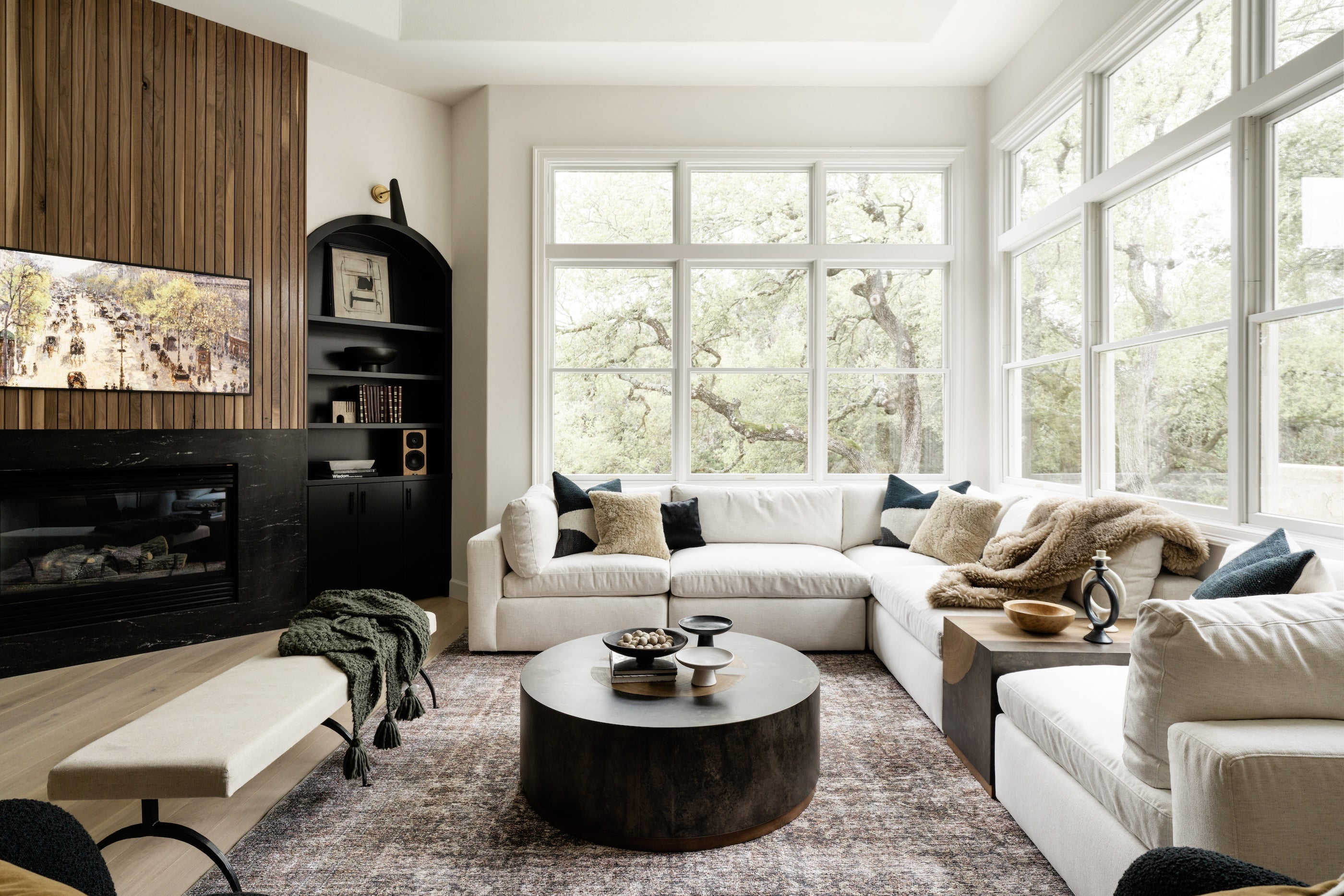Whether it’s picking bathroom tiles or choosing living room paint colors, every designer has had to deal with one spouse not agreeing with the other on a design choice. This week, we asked 14 designers—LeeAnn Baker, Lissette Fernandez-Hilson, Sydney Foley, Judi Fuller, Barbara Glass, Emma Legg, Chelsea Lembi Murawski, Corine Maggio, Aimee Meisgeier, Kriste Michelini, Alexis Pew, Karen Post, Rachael Stollar and Ryann Swan Hackett—how they handle spousal disagreements.

Common Ground
“Clearly, I didn’t realize that a career in interior design meant one also needed a minor in couples therapy! However, we are happy that both are emotionally invested in the turnout. While occasionally our couples don’t see eye to eye, we take the time to hear them out completely. Afterward, we break it down and focus on finding common ground, where all objectives and functionality are met, then stretch our design muscles to create an aesthetic that is equally pleasing to both.” —Judi Fuller, J. Fuller Interiors, Austin

Equal Input
“The key is to make sure both people trust you entirely. The best way to do that is to make sure everyone feels heard and validated, then give an honest and diplomatic response to conflict and disagreements. It’s not unusual for there to be one spouse more involved than the other, but it’s super important that the less-involved spouse knows that their opinions are being taken into consideration even when they’re not in the loop. That said, I will not start a project or do a style study unless all decision-makers are involved in that early discovery phase—that initial [period] is a crucial opportunity to establish much-needed trust.” —Corine Maggio, CM Natural Designs, San Francisco

Level Set
“The first thing we do with every client is have them fill out a detailed questionnaire. When working with a couple, we ask each to fill out the questionnaire as individuals, not as a couple. Then we tell them to each print out their questionnaire, book a date night and use it as a fun way to learn about and listen to each other’s design preferences. A lot of times, they think they are on the same page and [discover] they are not. We also have a fun (and effective) design game we play to show them where their common ground is. We use the questionnaire and the game to land a north star for their design that incorporates both of their styles so they feel that we are already starting with both of their wants in mind. If we weigh in [during a disagreement], we always have the same objective: Point out the things they have in common, be neutral, be professional and have an opinion—that’s why they hired us!” —Lisette Fernandez-Hilson and Chelsea Lembi Murawski, Together Home, San Francisco

Neutral Stance
“When handling spousal disagreements, I try to identify the common goals, offer compromise solutions and educate clients on design principles. We set priorities, present alternative options and always maintain transparency in communication. This method has consistently proven to be highly effective to resolve conflicts among couples, and then we are able to forge ahead.” —Kriste Michelini, Kriste Michelini Interiors, Danville, California

Point of Contact
“At the outset of every project, we send a client questionnaire and ask one person to be the lead point of contact for the duration of the project. This helps get people in the habit of communicating around the project.” —Rachael Stollar, Studio SFW, New York

Make Connections
“I’ve found repeating comments and noting them in meeting reports helps confirm points of view and keeps the goal of finding a middle happy point. I also find out how each side has made money and what industry they understand to use examples from their world. [From there, use] your referee hat. You have to establish your boundaries not as the dictator, but the navigator. I have found in most cases, [the solution to disagreements] is education. The faster you can show a client something that you know is the right direction, you can enlighten and teach folks, then the conflicts will decrease.” —Karen Post, Home Frosting, Tampa, Florida

Assign Clear Roles
“Navigating spousal disagreements during client projects demands a delicate balance of active listening and empathy to ensure both partners feel heard and understood. To minimize conflicts and frustration, we strive to establish clear boundaries and roles for each partner within our projects. By delineating responsibilities and decision-making authority, we mitigate misunderstandings and maintain clarity throughout the process. For example, when one partner is very particular about how the kitchen might be laid out, we will make sure the other partner has their voice heard in another area of the house that is of primary interest to them, such as the office, family room or even garage. Full transparency with both parties cultivates an atmosphere conducive to constructive dialogue, which enables us to focus on finding solutions rather than assigning blame or revisiting past disagreements.” —LeeAnn Baker, LeeAnn Baker Interiors, Seattle

Don’t Be Afraid to Pivot
“When encountering disagreements, I try to stay as neutral as possible. I will gauge who has more passion about their idea and ask them to explain to their significant other why they are so enthusiastic about it. Hopefully, this encourages the other partner to compromise. I remind the compromising spouse that at some point, there will be something that they will have a strong opinion on, [where] their partner can then accommodate them and their ideas. If neither person wants to cave, I will suggest pivoting altogether to find a happy medium—one that both will agree to, but that still works with the design concept, hopefully keeping the project on track.” —Aimee Meisgeier, AM Interior Design, Seattle

Communication Is Key
“Our design process is built on collaboration, consensus building and clear communication. We find most disagreements arise from poor communication, which is why we make attendance at design meetings mandatory for all decision-makers. Getting delayed or secondhand feedback slows down the design process and can lead to frustration. Having all stakeholders present and engaged during meetings is critical to the success of a project. Effective communication also requires active listening by the design team. It is important to hear what is being said—and, equally important, what is not being said. We want to make sure everyone’s voice carries equal weight in the design process.” —Alexis Pew, Kaminski + Pew, Philadelphia

Know Their Niche
“What I focus on first is ensuring that each party feels heard. Here’s a great example: When we recently presented a dining room bathed in the most gorgeous green hue, the wife loved it but the husband did not. We spent time to really understand if it was the furniture forms he did not like, or the wallcovering print, or something else. By the end, the wife remembered that the husband is color-blind and can’t see the color green, so the poor guy was seeing a gray room. No wonder he found it so lackluster! Oftentimes, we also try to give each partner their own niche of ownership. I find that husbands tend to have stronger opinions on more high-touch areas of the house, so we usually go shopping with them for things like door hardware and plumbing fixtures. Knowing that they have had hands-on experience with an important selection eases their minds when a lot of the items we are selecting (custom furniture, for example) are pieces they will not see until install. I think giving people a specific area of control allows them to feel less overwhelmed and more in the driver's seat.” —Ryann Swan Hackett, Ryann Swan Design, New York

Lots of Options
“Our job is to make both spouses happy and knock their socks off, giving them a space beyond their wildest dreams. We do this most often by offering several choices and options when it comes to anything requiring a decision. It could be multiple floor plan layouts or finish selections like tile, wallpaper and fabrics. We look for that sparkle in their eye when they love something, and we are able to blend the favorites of each spouse into a cohesive design they both love. They both end up happy because they’ve each played a role in the decision-making process that ultimately creates a space that reflects them together.” —Sydney Foley and Emma Legg, Kindred Interior Studios, Summerfield, North Carolina

Choose Your Battles
“If I sense someone is feeling overlooked or overshadowed by a stronger, more opinionated partner, I make a conscious effort to engage them, asking questions to include them in the discussion and promote a dialogue where everyone’s feedback is reflected. When serious disagreements happen during a meeting, I advocate for a ‘pick your battles’ approach, encouraging couples to voice concerns that truly matter while letting go of minor disagreements. With all relationship issues, it is all about compromise. Home design can stir up emotions and disputes, especially when finances are involved. But by fostering mutual respect and trust in the process, I aim to make the experience straightforward and, more importantly, enjoyable for everyone involved.” —Barbara Glass, Barbara Glass Inc., Aspen, Colorado





























